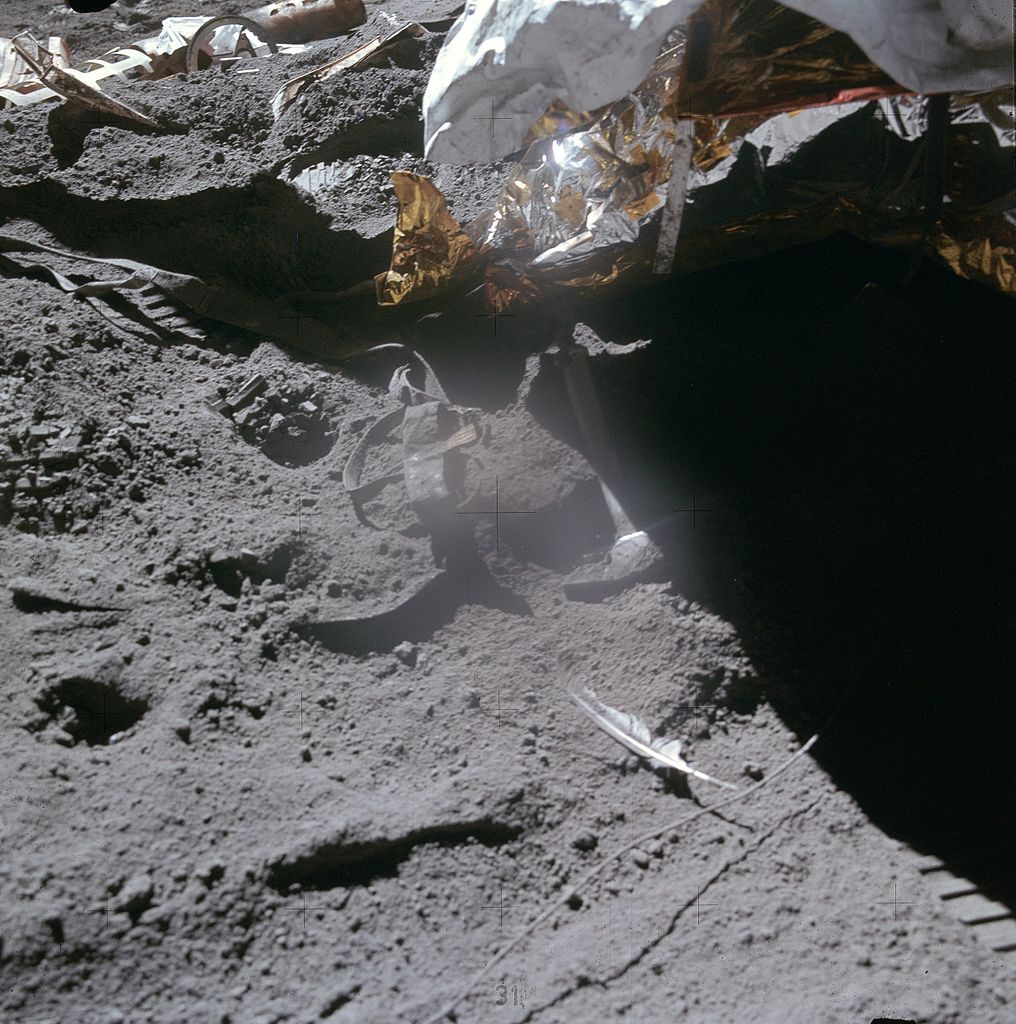Object of Intrigue: The Falcon Feather on the Moon

The Apollo 15 lunar module, Falcon, on the moon in 1971. (Photo: NASA)
When astronauts go to the moon, they tend to litter. Besides the generic debris—spent bits of spacecraft; empty food bags; full vomit bags—other, more distinctive remnants of each Apollo mission remain. The two golf balls hit by Apollo 14’s Alan Shepard in February 1971 still lie on the lunar surface, as does a family portrait that astronaut Charles Duke left there during the Apollo 16 mission in April 1972.
Then there is an even more delicate object: a falcon feather, dropped during the Apollo 15 mission and left there ever since.

The falcon feather left on the moon. (Photo: NASA)
Mission commander Dave Scott brought the feather to the moon in order to conduct an experiment. Sometime during your life, likely in a science class context, you’ve probably encountered a version of the following question: When dropped from the same height, what will hit the ground faster, a bowling ball or a feather?
On Earth, where there is a nitrogen- and oxygen-dominant atmosphere, the ball will hit the ground first—not because it’s heavier, but because the feather encounters air resistance on the way down. But things are different on the moon. Because there is an infinitesimal amount of air in the moon’s atmosphere, air resistance is not an issue, and a feather and a bowling ball dropped from the same height would hit the ground at the same time.
The idea that, in the absence of wind resistance, two different objects would accelerate at the same rate when dropped goes all the way back to 1589, the year of Galileo’s Leaning Tower of Pisa Experiment. Legend holds that the great scientist dropped two balls of varying mass from the tower in order to demonstrate that they accelerate uniformly, regardless of their mass. Though debate continues over whether the story is apocryphal, Galileo certainly wrote about his hypothesis in the form of thought experiments. He eventually arrived at a “law of falling bodies,” which stated that all bodies fall at the same speed in a vacuum.

Dave Scott goes on moonwalk number two during the Apollo 15 mission. (Photo: NASA)
In 1971, astronaut Scott decided to replicate Galileo’s experiment in the most intense vacuum possible. Toward the end of his third and final moon walk of the mission, Scott turned to face the lunar TV camera and told the folks back home what he was about to do:
Well, in my left hand I have a feather; in my right hand a hammer. I guess one of the reasons we got here today was because of the gentleman named Galileo. A long time ago, he made a rather significant discovery about falling objects in gravity fields; and we thought—where would be a better place to confirm his findings than on the Moon?
Scott had been planning this experiment for the better part of a year. In January 1971, he and fellow Apollo 15 astronauts Jim Irwin and Al Worden visited the Air Force Academy in Colorado Springs, where they met the falcons that serve as the Academy’s mascots. Because their lunar module was named Falcon, they had decided to use a falcon feather for the Galileo experiment, and collected two feathers from an Academy bird during their visit.

Astronauts Worden, Scott, and Irwin with a falcon at the Air Force Academy in January 1971. (Photo: NASA)
The original plan was for Scott to do a trial run of the experiment on the moon, using the first feather—just to make sure that the static from his glove wouldn’t affect the way it fell. But they ran out of time during the last moon walk. Facing the camera with feather and hammer in hand, Scott ditched the planned practice run and, in his words, “winged it.” He unclenched his fists. As predicted, the feather and the hammer hit the surface of the moon at the same time:
The result was no big surprise, but it did represent a nice bit of posthumous validation for poor old Galileo, whose ideas were often received less than favorably back on Earth.
As far as NASA knows, the hammer and the feather are still on the lunar surface—remnants of an experiment that had its origins in the 16th century, roughly 238,900 miles away.



























Follow us on Twitter to get the latest on the world's hidden wonders.
Like us on Facebook to get the latest on the world's hidden wonders.
Follow us on Twitter Like us on Facebook